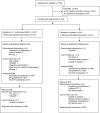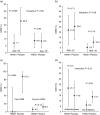Early pregnancy probiotic supplementation with Lactobacillus rhamnosus HN001 may reduce the prevalence of gestational diabetes mellitus: a randomised controlled trial
- PMID: 28367765
- PMCID: PMC5426322
- DOI: 10.1017/S0007114517000289
Early pregnancy probiotic supplementation with Lactobacillus rhamnosus HN001 may reduce the prevalence of gestational diabetes mellitus: a randomised controlled trial
Abstract
The study aims to assess whether supplementation with the probiotic Lactobacillus rhamnosus HN001 (HN001) can reduce the prevalence of gestational diabetes mellitus (GDM). A double-blind, randomised, placebo-controlled parallel trial was conducted in New Zealand (NZ) (Wellington and Auckland). Pregnant women with a personal or partner history of atopic disease were randomised at 14-16 weeks' gestation to receive HN001 (6×109 colony-forming units) (n 212) or placebo (n 211) daily. GDM at 24-30 weeks was assessed using the definition of the International Association of Diabetes and Pregnancy Study Groups (IADPSG) (fasting plasma glucose ≥5·1 mmol/l, or 1 h post 75 g glucose level at ≥10 mmol/l or at 2 h ≥8·5 mmol/l) and NZ definition (fasting plasma glucose ≥5·5 mmol/l or 2 h post 75 g glucose at ≥9 mmol/l). All analyses were intention-to-treat. A total of 184 (87 %) women took HN001 and 189 (90 %) women took placebo. There was a trend towards lower relative rates (RR) of GDM (IADPSG definition) in the HN001 group, 0·59 (95 % CI 0·32, 1·08) (P=0·08). HN001 was associated with lower rates of GDM in women aged ≥35 years (RR 0·31; 95 % CI 0·12, 0·81, P=0·009) and women with a history of GDM (RR 0·00; 95 % CI 0·00, 0·66, P=0·004). These rates did not differ significantly from those of women without these characteristics. Using the NZ definition, GDM prevalence was significantly lower in the HN001 group, 2·1 % (95 % CI 0·6, 5·2), v. 6·5 % (95 % CI 3·5, 10·9) in the placebo group (P=0·03). HN001 supplementation from 14 to 16 weeks' gestation may reduce GDM prevalence, particularly among older women and those with previous GDM.
Keywords: Lactobacillus rhamnosus HN001; Fonterra Fonterra Co-operative Group Ltd; GDM gestational diabetes mellitus; GTT glucose tolerance test; HN001 Lactobacillus rhamnosus HN001; IADPSG International Association of Diabetes and Pregnancy Study Group; NZ New Zealand; RR relative rate; Gestational diabetes mellitus; Probiotics; Randomised controlled trials.
Figures


References
-
- Ministry of Health (2014) Screening, Diagnosis and Management of Gestational Diabetes in New Zealand: A Clinical Practice Guideline. Wellington: Ministry of Health.
-
- American College of Obstetricians and Gynecologists Committee (2013) ACOG Committee opinion number 549: Obesity in pregnancy. Obstet Gynecol 121, 213–217. - PubMed
-
- Ben-Haroush A, Yogev Y & Hod M (2004) Epidemiology of gestational diabetes mellitus and its association with type 2 diabetes. Diabet Med 21, 103–113. - PubMed
-
- Kim C, Newton KM & Knopp RH (2002) Gestational diabetes and the incidence of type 2 diabetes. Diabetes Care 25, 1862–1868. - PubMed
Publication types
MeSH terms
Substances
LinkOut - more resources
Full Text Sources
Other Literature Sources
Medical

